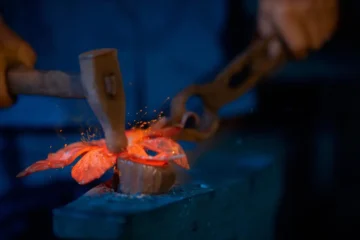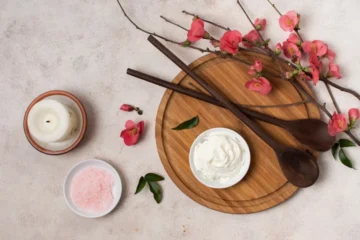Granite is an extremely popular choice for kitchen and bathroom countertops. The elegant stone owes this immense popularity to its longevity and durability. It is a strong stone that will not only enhance the functionality and practicality of the room it is installed in, but it will also elevate the beauty of the room with its striking looks.
Installing granite countertops might seem daunting, however through careful planning, you can achieve excellent results that look professional. Keep reading to find out how to install granite countertops step-by-step and discover all of the tips and tricks.
Selecting Your Granite Slab
Choosing the right slab is one of the most important and crucial steps. The right slab will lay the foundation for your renovation project. Granite is available in a wide range of colors and patterns. This allows homeowners to express their style and creativity. However, it might also make the design process harder. Having a preplanned idea about how you want your countertops will make the decision easier.
Examine the slab closely to detect its quality and see if there are any blemishes throughout the stone. Cracks and chips, if they are small, might appear harmless, leading you to believe they won’t pose a problem in the long run. However, such problems might grow over time, leaving you to deal with damaged countertops.
Ensure that the measurements of the slab fit the space you are going to install them. If the slab is too small, it won’t be able to cover the countertop space. Moreover, consider any cutout you’re going to need, such as the sink or other appliances.
Preparing Your Space
Properly preparing the space is an often overlooked, yet important step. If you want to be able to use your countertops functionally, you need to make sure they are fully supported.
The first step is to remove the old countertops. Don’t damage the cabinets underneath as they will be the support system of your new countertops. If you need to disconnect appliances or plumbing before disconnecting the countertops fully, you should handle that before attempting to remove the countertops.
Granite is a very heavy stone. Therefore you are going to need strong cabinetry so they can carry the slab. Check if there are any signs of weakness or instability. If you locate them, reinforce and use a level to ensure the evenness of the cabinets.
The last step of the prep is to create a template for the countertops using cardboard or plywood. This is to ensure that your measurements are correct and you won’t make any irreversible mistakes while cutting the granite slab.
Cutting the Granite Slab
Cutting the granite requires a lot of precision and planning. For this step, you might also consider hiring a professional for the best results. If you decide on cutting the slab yourself, double and even triple-check all of the measurements before making the cut. You won’t want all of your hard work to go to waste because of a simple mistake. Understanding how to install granite countertops includes paying attention to ensuring each cut is perfect.
As granite is an incredibly hard stone, therefore, you are going to need a saw with a diamond blade. Wet saws are a great option as they create less dust while cutting. Always wear protective gear. The granite dust and particles might get into your eyes, nose, our mouth causing irritation, hearing loss, or other unwanted consequences.
Mark the granite using the template. While cutting the granite don’t use excessive force, allow the saw to do the work. Apply gentle and even pressure until the slab is cut through.
Dry Fitting the Countertops
Before the countertops are secured permanently on the cabinets, you should do a dry fitting to ensure that the fit is correct. Carefully place the granite slabs on the cabinets. Examine the fit of the countertops so that there aren’t any gaps, or uneven edges and a seamless shape is achieved.
If the shape and measurements of the countertops are correct, check for the evenness of the countertops. Use a level to see if there are any high spots. If there are, you might need to sand some of the cabinetry to achieve an even finish.
If you notice any issues in this step, such as the evenness, the fit of the granite slabs with each other, the connecting areas, or the blend of the countertops with the backsplashes, you should try and correct them now. Such problems will be harder to address and fix once they are completely installed. Close inspection and careful measuring are important steps in learning how to install granite countertops.
Secure the Granite Countertops
Once you have ensured the fit is right and the slab is cut to accurate measurements, you can move forward with the installation. You should use a high-quality adhesive to achieve the best results. Silicone adhesives are recommended and they can hold the granite in place and prevent it from shifting.
Set the granite slabs in their place carefully, then gently yet firmly press on the slabs so that the adhesive can get a good hold. Make sure that the seams match and the countertops are properly aligned.
Sealing and Finishing Touches
Sealing the granite is a step you must not skip. Sealing the stone protects it from outside elements such as moisture, dirt, and oils. As a natural stone, granite has a porous structure. This means that it has tiny holes all over it that can house bacteria and even mold. Therefore, sealing the countertops is an essential step.
Before sealing the countertops, clean the surface thoroughly to prevent dirt from getting trapped under the sealer. Then apply the sealer using a clean cloth in an even layer. Read and follow the instructions on the sealer package closely.
Let the sealer sink in for 15-20 minutes, then wipe the excess of the sealer off. Don’t use the countertops for 48 hours so it has time to fully cure. Additionally, you can use a caulk that matches the color between the countertops and the wall. This will achieve a finished look and prevent any possible damage.
Maintenance After Installation
Maintaining granite countertops after installation is a crucial part of the process that will ensure the longevity of the countertops. Although it is a durable material, it still requires regular care and maintenance steps to look its best.
The most important part of granite maintenance is resealing them periodically. As it is a porous stone, it needs to be resealed at least annually to protect it from stains and bacteria. Skipping this step may result in the countertops getting stained or discolored.
There are a few tests you can conduct to see if it is time to reseal the countertops. The first is to see if the countertops still look shiny. If they are starting to look dull and matte, it is time to reseal them. The second test is to drop a few water droplets on the countertops. If the droplets bead up on the surface, the sealing is still intact, if they get absorbed into the stone, they are ready for resealing.
Regular cleaning is another important aspect of granite maintenance. Wiping the countertops daily will help retain their luster and shine. You can use a soft microfiber cloth or sponge with mild dish soap. Avoid using harsh chemicals or abrasive materials as they can cause damage to the countertops with continuous use.
The best way to combat stains is to prevent them from happening in the first place. Wipe any spills as soon as they occur so the liquid doesn’t have time to seep into the stone to cause potential stains or discoloration. Acidic substances such as coffee, wine, and citrus juices are especially prone to causing stains, therefore use coasters and pay special attention to cups or containers that contain these liquids.
Common Granite Countertop Issues
Although granite is known for its durability and longevity, it too can face issues over time as it gets daily use. Being knowledgeable about these issues will help you prevent them and deal with them in instances where they are unavoidable.
One of the most common issues with countertops is stains. You might do your best to avoid them altogether but sometimes accidents happen and stains occur. Oil, wine, and coffee can cause stains if left unattended.
In that case, you can use a baking soda paste to remove the stain. Mix baking soda with some water to create a paste. Apply the paste over the stained area and cover it with plastic wrap. Let the paste sit for a few hours, then check if the stain is removed. If it is, remove the paste and thoroughly clean and dry the area.
If the stain persists, you can leave the past overnight. If leaving the paste overnight doesn’t fix the issue, you can try cleaners that are made specifically for stain removal or consult with a professional.
Etching is another common countertop issue. This can manifest in the form of a dull spot or light discoloration. Etched surfaces will look less shiny from the surrounding areas. Using pH-balanced cleaners is a good way to avoid etching. To fix the issue you can lightly buff the spot until the mark is no longer visible. Then clean the area and apply a sealer to avoid further problems.
Granite countertops can get discolored due to build-up over extended use. This is an especially common problem in areas with hard water. The best way to avoid build-up on the countertops is to wipe them daily and dry them using a soft cloth. Leaving wet countertops to dry on their own will cause the minerals in the hard water to cling to the countertops, resulting in a light white layer, thus the countertops will look older than they are.
By following this guide on how to install granite countertops, you will achieve a professional-looking appearance in your countertops. Moreover, you will save money and gain the satisfaction of completing this beautiful project by yourself.




